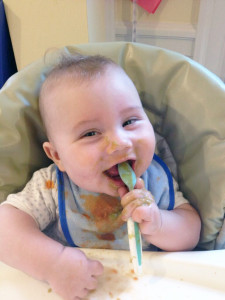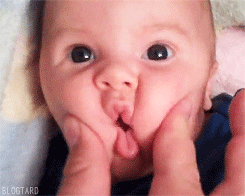Hi there, mammals. I mean, mamas. We are mammals, and we have mammary glands – breasts – that serve a function: feeding babies. Whether they’re in use or not, as the saying goes, “that’s what they’re there for.” So it’s a sad statement on our current culture that we even need to establish legal protections, fight to keep photos on Facebook, or lobby PBS to show the occasional breastfeeding baby “back” on Sesame Street to keep his bottle-feeding friends company.
If breastfeeding were the cultural norm, a nursing baby would be… well, unremarkable. They’d be everywhere. Commonplace. On the bus. In the park. At the coffee shop, in the store, at older siblings’ soccer games. Instead, we need legislation to protect a woman’s right to nurse wherever she is legally allowed to be, so that she can’t be harassed by unenlightened store clerks or hustled away by mall security.
A nursing mom usually just wants to feed and nurture her baby then get on with her day, and isn’t out to make a political statement. Yet, by breastfeeding your baby in comfortable public locations, you are doing something culturally significant each time. In addition to nourishing and nurturing your baby, you’re also doing some subtle public education reminding people that breastfeeding is, in fact, the biologically normal and expected way to feed a baby. In our bottle-feeding society, that’s an important reminder. Though initiation rates nationally are about 75%, fewer than half of American babies are breastfeeding at all by six months, and only one in four babies are nursing at all at one year. The more we, as a nation, see babies nursing, the more normal it will be, and the less fuss – and stress – will be made. So, mamas, do your part, be a mammal and feed your babies where and when you and your baby are comfortable.
My suggestions for breastfeeding when you’re out and about and away from your home:
1. Start early. Practice often.
Nursing isn’t always easy in the early days. Some moms have a very specific set-up at home with a certain chair, foot stool, pillows positioned just-so, and plenty of visibility and patience, to help get their baby latched on comfortably. It may take multiple attempts. There may be tears. The baby cries, too. It can be loud and messy. Keep at it. Get help if you need it. The first two weeks are the hardest. It gets better.
2. Get out of there.
Don’t get locked into the mindset that you need to be at home to make breastfeeding work. Even in the early days, with practice, you’ll begin to find it easier to get out of the house and feed your baby in a variety of settings. You’ll appreciate building flexibility and developing confidence into your ability to nurse on the go. You’ve got to get out of that house. Isolation is painful, and you’ll also discover that your baby is often happier and easier to care for when you’re out and about.
3. First times venturing out? Go where the moms go.
Find out what’s in your area. Breastfeeding groups, new mom gatherings or mom and baby yoga classes are perfect places to start. Being in a clean, nurturing, private location surrounded by other new mothers also focused on caring for their babies makes for a comfortable place to practice feeding. No one will notice or care if your baby fusses, or you fumble a bit.
4. Plan one outing a day with a “Rest & Refuel” in the middle.
Get out every day, but one outing is likely all that’s feasible. DO NOT attempt to rush through your errands to be back home within a two-hour window before the next feeding. Instead, PLAN IN a time and place you can sit and rest, have a snack yourself, and nurse your baby before continuing with your outing. For example, return baby gift and walk around mall, make a pit stop at coffee shop for snack/nursing/bathroom/diaper change, then continue on to the grocery store, then home.
5. Choose your spots wisely.
Select places that are family-friendly and accustomed to children, places where you will feel most comfortable. Coffee shops, book stores, and “ladies lounges” are popular spots to nurse when you’re out and about. Do not nurse in a bathroom stall! If initially you prefer more privacy, your car or a fitting room is a far cleaner alternative. Don’t ask for permission. You don’t need to give anyone power over where you may or may not feed your baby. Want to use a fitting room to nurse? Just grab something off a rack and bring it in with you to “try on”.
6. Fine Dining?
In a restaurant setting, ask for a table where you will feel most comfortable. Some women find a booth gives them more privacy; others (especially those with bigger breasts or older babies) find they don’t have enough room to maneuver and prefer a table with moveable chairs. Some women like to sit with their back to the room, and others prefer to sit facing out. Experiment and find what works best for you and your baby. As an aside, try breakfast or lunch in a restaurant rather than dinner. Young babies are often happier early in the day and tend to be a little crankier in the evening.
7. Park it. Bench it.
In a mall or park, find a bench in a quiet area and park your stroller in front of you, then put the stroller brakes on. Now you have a bit of a privacy barrier and can also prop your feet up on the wheel or basket as a makeshift foot stool. This will help you be more physically comfortable and angle your lap for easier positioning. When the weather is nice, sitting on the grass with your back against a tree for support makes for a lovely “dining al fresco” experience.
8. Used to a nursing pillow? Try these makeshift tricks for extra support and lift:
Fold up your coat or sweater and rest it in your lap as a nursing pillow.
Tuck your diaper bag under your thigh to bring your lap higher.
Roll up a receiving blanket: this may be all you need to support your baby’s head or your own wrist for a more comfortable position.
9. What to wear?
Nursing tank-tops make it easy to turn any top into a nursing shirt. Pull up your shirt from the bottom: the nursing tank will keep your belly and side (aka muffin top) completely covered and warm. A little leaky? Choose tops with patterns rather than solid silky colors, they’ll hide all sorts of splotches from you or your baby. Hint: Always keep an extra shirt for yourself, and an extra onesie and outfit for your baby in a zip seal bag at the bottom of your diaper bag. Babies spit up or have diaper blow outs at the most inopportune times!
10. Nothing to see here, folks.
When a mom and baby are nursing, there’s usually nothing too exciting to see. Take the time to get your baby settled and latched on comfortably, then adjust your clothing, pick your head up and smile. When people walk by and look at you, they’re probably hoping to get a glimpse of “the sleeping baby” in your arms. Take a look in the mirror, or ask a friend or family member to take a photo so you can see… that there’s just really nothing much to see. This might help you feel more confident when nursing in different locations.
11. Nursing Cover Ups?
Breastfeeding is normal and doesn’t need to be hidden, yet each woman has her own level of comfort or modesty. I hope there are many (most!) places where you feel very comfortable nursing, but there may be occasional times or places when you prefer more privacy. Nursing cover-ups offer privacy but allow air to circulate, the baby is not covered by a heavy blanket, and mom and baby can see each other.
Around 4 – 5 months, some babies become more distracted when feeding and a nursing cover may help them stay focused on the task at hand, though some babies refuse to feed under a cover.
Pumping? A nursing cover is also helpful if you have a semi-private place to pump at work. Everyone knows what’s going on under there – baby or pump, chances are, you’re not hiding anything – but if it makes YOU more comfortable, that’s what’s important.




